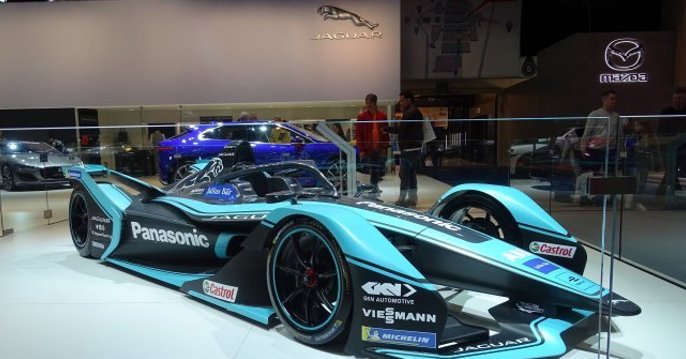Their characteristic noise is also one of their greatest sources of criticism. Electric Formula cars, more commonly known as Formula E, have, over the last couple of years, become a playground not only for drivers, but also for engineers and manufacturers who experiment with electric motors. Motor racing has always been an opportunity to see through new innovations. In the past, some of the techniques developed on vehicles intended for endurance races, for example, have later been used on commercial models. Formula E could even help some manufacturers meet their targets to reduce greenhouse gas emissions.
Clean energy lab
Formula E now seems to be in step with the times: confronted with environmental critics who stir at each race, these single-seaters have been driving without emitting CO2 since the 2014/2015 season. Interesting fact: while the tyres, batteries, and the chassis are the same for all teams, the powertrain, which includes the engine and the transmission, has to be supplied by each manufacturer. In addition to the talent of the drivers, the key to winning thus lies under the bonnet, and, more precisely, in the technical contributions of the individual engine manufacturers.
One of the major challenges is battery life and recharge time. Both are also key factors for consumers on the market, as sales of electric vehicles in Europe have risen sharply after lockdown. In the early years of Formula E racing, cars had to charge their batteries during the race. Thanks to the work of engineers and new high-performance engines, this is no longer the case. Managing these batteries offers an additional interesting aspect to the race. The control of accelerating and braking is one of the points to master in order to win the race, and spices up encounters between drivers.
Among the sport’s objectives is “the fight against climate change and deadly levels of urban air pollution”. It is the only racing discipline to have received the ISO 20121, a certification for sustainability in the events industry. Ana Inacio, inspector for SGS, explained: “Formula E has been embedding sustainability season-on-season — exploring new initiatives, engaging with local communities and suppliers, and applying robust impact assessments”. A simple case of greenwashing? While staff and teams travel between continents during the season, it must be acknowledged that Formula E is involved in sustainability efforts: it is a partner of the United Nations Environment Programme (UNEP) for instance.
European manufacturers play the game
The discipline is still in its infancy. The very idea of a competition between electric cars was born from a conversation between Frenchman Jean Todt, President of the FIA (Fédération Internationale de l’Automobile) and Spaniard Alejandro Agag, former politician and MEP, in 2011. Changes in the automotive field are necessary as CO2 emissions in the transport sector continue to rise in Europe. Manufacturers no longer have a choice as the European Union has imposed very restrictive emission standards.
German companies are particularly found on the championship tracks: Audi, BMW, Mercedes Benz and Porsche are committed and compete for victory, while the Chinese team Techeetah is equipped by French manufacturer DS, and Renault has obtained three titles for best team. The technical achievements enabled by the competition could be reflected in the manufacturers’ production vehicles. And this contributes to reinforcing their image: for example BMW has provided the competition’s safety cars with its i8 model, a hybrid and rechargeable vehicle.
A growing craze
While Formula E is still struggling to broaden its audience, Formula 1 is gradually losing its own. Season after season, the suspense, although it still exists between the mid-table teams, tends to diminish. The most powerful teams lead the way without leaving the rivals with much to fight over. “Sponsors, or partners that are ready to spend tens of millions a year have become rare, all the more so as Formula 1 vehicles convey an image that is sometimes blurred and controversial, mixing glamour and performance, but also a spectacle inaccessible to the citizens of the countries visited, exacerbated pollution, and… boredom on the track for the viewers both at the track and those watching on TV”, explained Bruno Camus, Professor of marketing at Kedge Business School, on French automobile news site autonews.fr. [1]
In Formula E, race outcomes are more unpredictable. Above all, for the first time, the winner of the 2021 championship will receive the prestigious title of “world champion”, which previously did not exist in this category. The races take place on urban terrain, in big cities, and despite their low media coverage, there is a real public enthusiasm, particularly in the major European capitals. “The number of Formula E spectators has doubled in three years,” Bruno Camus confirmed. This could be explained by rules that are sometimes more “fun” than in F1, such as the “Attack Mode”, which is activated when drivers move slightly out of the race trajectory and cross an “Activation Zone”: “as a reward for taking a slower path at the corner, they can collect an additional 35 kW”, which can be used in the following laps, as specified on the Formula E website.
The 2019-2020 season, disrupted by the pandemic, ended with six E-Prizes organised in the city of Berlin in August. In recent years, Paris has been involved by hosting the yearly French event, and has extended its contract with Formula E Operations until 2022. The city can count on national driver Jean-Eric Vergne (a ‘defector’ from F1 and two times Formula E champion) to stir up the public’s interest. He is not the only European sportsperson to shine in this discipline, as André Lotterer and René Rast (Germany), Stoffel Vandoorne (Belgium), Nyck de Vries (Netherlands), or the new champion, Antonio Félix de Costa (Portugal), are also at the starting line.
Can the European Union count on these ambassadors to speed up the race for energy transition? One thing is certain: while F1 declares it will be carbon-neutral by 2030, Formula E is, at the moment, “cleaner” than all of those involving engines, and the technological advances made in this field could certainly have a beneficial effect on future production of the manufacturers involved. Formula E now only needs to make its mark on the media scene to earn the respect that its Formula 1 cousin has earned over 70 years of being in the game. The race for prestige is not a race for speed.


Follow the comments: |
|
